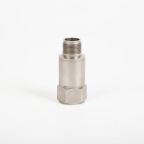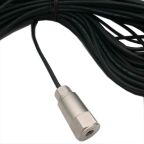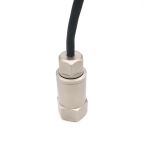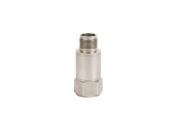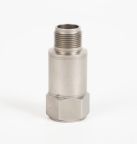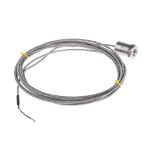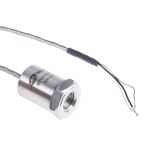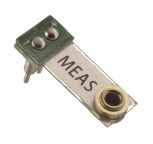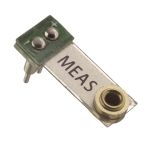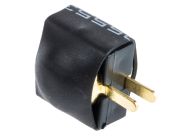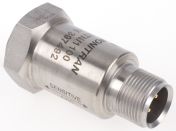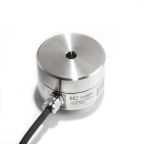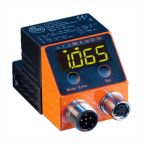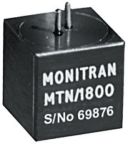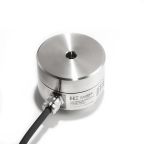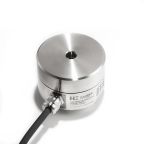Vibration Sensors
Vibration sensors, also known as piezoelectric vibration sensors or vibration probes, are versatile tools used to measure mechanical vibrations and related physical parameters in various applications. These sensors use the piezoelectric effect, which measures changes in pressure, acceleration, strain, or force by converting them to an electrical charge. Some advanced vibration sensors can also detect other parameters like temperature or resonance, making them multifunctional tools.
Sensor vibration measurements are critical in many industries for condition monitoring, fault detection, and predictive maintenance. For example, a vibration sensor for car applications helps detect engine imbalances, suspension issues, and other mechanical faults early, improving vehicle safety and performance. The range of vibration can vary greatly, so you should always specify vibration sensors to measure the maximum vibration range of your application.
Who Uses Piezoelectric Sensors?
Piezoelectric vibration sensors are widely used by professionals across multiple fields, including:
- Medical Industry: Used in diagnostic imaging (such as ultrasound), patient monitoring, and therapeutic devices, these sensors detect subtle mechanical vibrations critical for accurate diagnostics and treatment.
- Engineers and Industrial Technicians: Employed extensively in machinery condition monitoring, structural health assessments, and product testing to detect faults early and ensure operational reliability.
- Vehicle Designers and Automotive Engineers: Utilised to analyse engine performance, suspension dynamics, and drivetrain vibrations, helping optimise vehicle safety, comfort, and efficiency.
- Nuclear Technicians: Used to monitor vibrations in reactors and critical infrastructure to detect mechanical anomalies that could indicate safety risks or equipment degradation.
- Aerospace Professionals: Relied on to continuously assess aircraft engines, airframes, and landing gear, ensuring structural integrity and preventing catastrophic failures.
- Industrial Maintenance Teams: Used for predictive maintenance on pumps, motors, compressors, and other rotating equipment, minimising downtime and extending asset life.
- Research and Development Specialists: Utilised in experimental setups and product development to gather precise data on mechanical behaviours under various conditions.
Types of Piezoelectric Sensors
Piezo vibration sensors come in various configurations, each suited for different applications and environments. Understanding the key characteristics that differentiate these sensors will help you select the right model for your specific needs.
Ohms Rating
The ohms rating refers to the sensor’s internal electrical impedance. This parameter influences the quality of the output signal and its compatibility with data acquisition or monitoring equipment. Sensors with lower impedance typically provide stronger signals and are less susceptible to noise over long cable runs, making them suitable for industrial environments where signal integrity is critical.
Size and Form Factor
Piezoelectric sensors are available in multiple sizes and shapes, including variations in length, diameter, and overall form factor. The choice depends on the available mounting space and the sensitivity required. Smaller sensors are ideal for compact machinery or tight spaces, while larger sensors may offer enhanced durability or sensitivity. The form factor also affects ease of installation and the sensor’s ability to capture accurate vibration data.
Maximum Vibration Range
Each piezoelectric vibration sensor is rated for a maximum vibration amplitude it can safely measure without damage or signal distortion. Selecting a sensor with an appropriate vibration range ensures accurate readings and longevity. For example, applications involving heavy machinery with strong vibrations require sensors designed to handle high g-force levels, whereas delicate equipment may only need sensors rated for low-amplitude vibrations.
Mounting Style
Proper mounting is crucial for reliable vibration measurement. Piezoelectric sensors commonly offer several mounting options:
- Stud-mounted sensors: Provide a secure, permanent connection to the vibrating surface, ensuring excellent signal transmission and repeatability.
- Adhesive-mounted sensors: Allow quick and non-invasive installation, suitable for temporary measurements or when drilling is not possible.
- Magnetic base sensors: Offer flexibility for rapid deployment and repositioning on ferrous surfaces, ideal for diagnostic or maintenance purposes.
Choosing the right mounting style depends on the application’s permanence, surface material, and measurement accuracy requirements.
Directional Sensitivity
Piezoelectric vibration sensors can be designed to measure vibration along one or more axes:
- Uniaxial sensors: Measure vibration in a single direction, typically aligned with the primary axis of interest.
- Biaxial sensors: Capture vibration along two perpendicular axes, providing more comprehensive data for complex vibration patterns.
- Triaxial sensors: Measure vibration simultaneously along three orthogonal axes (X, Y, and Z), offering the most complete vibration profile. These are especially useful in applications where multi-directional vibration analysis is critical.
What is The Difference Between a Vibration Sensor and an Accelerometer?
The terms vibration sensor and accelerometer are closely related but not exactly the same, and understanding their distinction is important for selecting the right device.
- A vibration sensor is a general term for any sensor designed to detect and measure mechanical vibrations; oscillatory motions of a structure or machine. These sensors capture vibration signals that can be analysed to assess machine health, structural integrity, or environmental conditions.
- An accelerometer is a specific type of vibration sensor that measures acceleration, which is the rate of change of velocity. Accelerometers detect forces acting on a mass inside the sensor, converting mechanical motion into an electrical signal proportional to acceleration.
While all vibration sensors that measure acceleration are accelerometers, not all accelerometers are used solely as vibration sensors. Accelerometers can also measure static acceleration (like tilt) or transient events (such as shocks).
Things to Consider When Choosing a Vibration Sensor
Selecting the appropriate vib sensor is crucial for accurate monitoring and reliable data in any application. Here are the key factors to consider:
- Vibration Range and Sensitivity: Generally, if a machine produces high-amplitude vibrations, a low-sensitivity sensor is better to prevent saturation. If the vibration is less than 10 g rms, a 100 mV/g sensor should generally be used.
- Frequency: It is important to know the frequency span you need to measure to ensure the sensor can accurately capture the specific vibratory events, as sensors have defined operating frequency ranges.
- Temperature: High temperatures can affect the performance of piezoelectric sensors, leading to drift or reduced accuracy.
- Environmental Exposure: Consider protection against dust, moisture, and chemicals, especially for industrial vibration sensors.
- Hazardous Area Certification: Required for sensors used in explosive or dangerous atmospheres.
- Mounting Configuration: Choose from top exit, side exit, or low-profile sensors to fit space and installation needs.
- Vibration Sensor Cost: Prices vary widely depending on sensitivity, frequency range, environmental protections, and brand. While precision piezoelectric vibration sensors can be costly, investing in quality sensors reduces downtime and maintenance costs.
How Do Vibration Sensors Work?
Vibration sensors operate on the fundamental principle of detecting mechanical oscillations and converting these physical movements into measurable electrical signals.
Piezoelectric vibration sensors, for instance, generate an electrical charge when deformed by vibration. Similarly, capacitive sensors detect tiny changes in electrical capacitance caused by vibrating plates, while MEMS (Micro-Electro-Mechanical Systems) sensors use microscopic structures that deflect under vibration.
The resulting electrical signals, which can be either analogue or digital, are then processed and analysed to determine characteristics like amplitude, frequency, and waveform. Sensor sensitivity and their specific frequency range are critical parameters, influencing their ability to accurately capture and respond to various vibratory events across diverse applications.
Advantages and Limitations of Vibration Sensors
Vibration sensors offer significant benefits for monitoring and analysis, though they also come with certain considerations.
Advantages of Vibration Sensors
- High Sensitivity: Capable of detecting even subtle vibrations for early fault detection.
- Real-Time Monitoring: Provide immediate data for rapid response and preventative maintenance.
- Compact Size: Easily integrated into various machinery and systems.
- Durability: Many industrial vibration sensors are designed to withstand extreme conditions.
Limitations:
- Noise Susceptibility: External electrical or mechanical interference can affect readings.
- Cost: Advanced vibration sensors with high accuracy can be expensive.
- Installation Challenges: Proper mounting is critical for accurate readings, which can sometimes be complex.
Environmental Constraints
Factors like extreme temperature, dust, or moisture may significantly impact sensor performance and reliability, requiring specially protected models.
Mounting and Placement Guidelines
It is important to install vibration sensors properly to ensure accurate data collection, which is crucial for effective machinery monitoring and diagnostics. Here is general guidance covering the steps:
- Correct Placement: Improper installation can lead to inaccurate readings, as the sensor might not be detecting the true vibration of the component. Always place the sensor directly on the vibrating surface or as close as possible.
- Mounting Methods: Discuss options like adhesive mounting for temporary or non-intrusive applications, stud mounting for permanent and robust connections, or magnetic bases for quick, repeatable placement on ferrous metals.
- Orientation and Axis Considerations: Ensure the sensor is aligned correctly with the axis of vibration you intend to measure. Most sensors measure in a specific direction (e.g., uniaxial, triaxial); misalignment can lead to misleading data.
- Surface Preparation: Prior to mounting, ensure the surface is clean, flat, and free from paint, grease, or debris for optimal sensor contact and reliable vibration transmission.
- Vibration Transmission Paths: Be aware that structure-borne noise from adjacent components can affect measurements. Choose mounting locations that isolate the vibration sensor from extraneous vibrations to get accurate data from the target.
Applications of Vibration Sensors
Vibration sensors are widely used across diverse industries for condition monitoring, predictive maintenance, and quality control:
Automotive Industry
Vibration sensors are widely used in the automotive industry for detecting imbalances, analysing engine performance, and identifying suspension issues. They are crucial for monitoring engine knocking, wheel bearing faults, and overall ride quality in cars, which aids in diagnostics and preventative maintenance, ensuring vehicle safety and comfort.
Aerospace and Aviation
In aerospace and aviation, vibration sensors are vital for structural health monitoring and diagnostics of aircraft components, including engines, airframes, and landing gear. They help detect early signs of fatigue, cracks, or loose parts, which is critical for ensuring aircraft integrity and preventing catastrophic failures during flight operations.
Industrial Equipment
Vibration sensors are essential for monitoring pumps, motors, fans, and gearboxes in industrial settings. A vibration alarm sensor can detect abnormal vibration patterns, allowing for early intervention and preventing costly equipment downtime. This proactive approach significantly enhances machine safety and extends asset lifespan.
Consumer Electronics
In consumer electronics, vibration sensors are integrated into devices like phones, game controllers, and smart wearables. They enable features such as haptic feedback (vibrations for alerts or gaming), step counting, gesture recognition, and drop detection, enhancing user experience and device functionality.
Infrastructure Monitoring
Vibration sensors are employed for the vibration analysis of bridges, buildings, and rail tracks to monitor their structural integrity. They help detect seismic activity, assess stress from heavy traffic, and identify potential weaknesses, which is crucial for ensuring the long-term safety and stability of infrastructure and maintaining workplace safety.
Trusted Vibration Sensor Manufacturer, Supplier & Distributor in Malaysia
RS is your trusted source for vibration sensors in Malaysia. As a trusted manufacturer, supplier, and distributor, we offer a wide selection of cost-effective and high-quality vibration sensors from top brands like Hauber Elektronik, TE Connectivity, and our own RS PRO. Get vibration probes, vibration alarm sensors, and more from RS and experience quality, reliability, and expert advice.
Explore other essential sensors like pressure sensors and proximity sensors to enhance control, ensure safety, and optimise performance across a wide array of industrial automation and monitoring systems. We offer competitive prices and a seamless online ordering experience. Enjoy fast, nationwide doorstep delivery. For detailed delivery information and fees, visit ourDelivery page.
Popular Searches
Related links
- TE Connectivity Vibration Sensor, 0°C → +70°C
- KEMET Vibration Sensor 600 μA Max -25°C → +85°C
- Hauber Elektronik Vibration Sensor 30V Max -40°C → +60°C
- Allen Bradley Vibration Sensor -55°C → +120°C
- RS PRO Vibration Sensor 20 mA Max 1 kHz, -40°C → +85°C
- Banner Vibration Sensor 9 mA Max -40°C → +105°C
- Assemtech Vibration Sensor -37°C → +100°C
- TE Connectivity Vibration Sensor -20°C → +60°C

